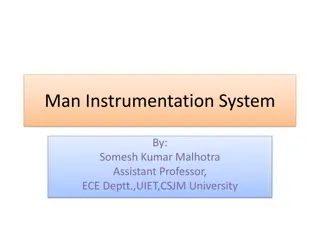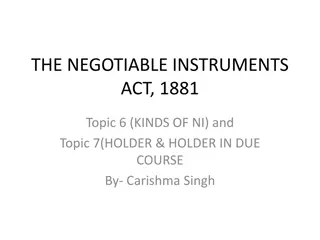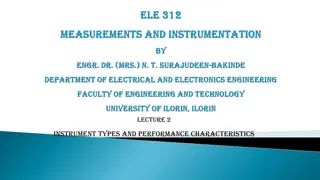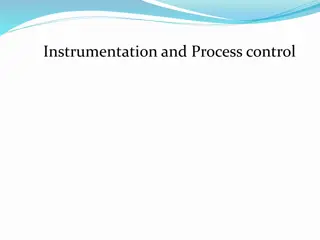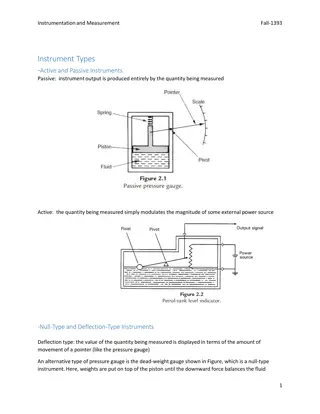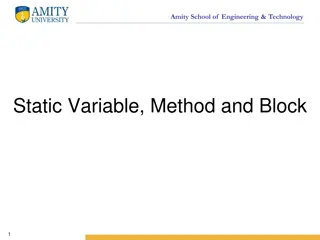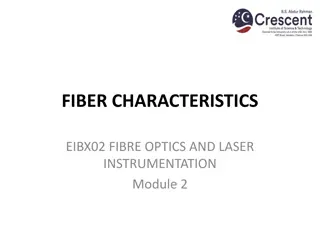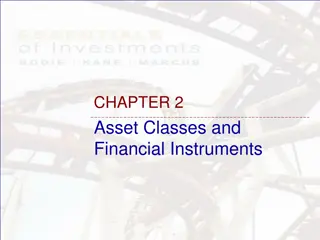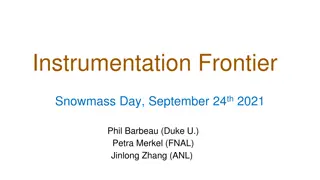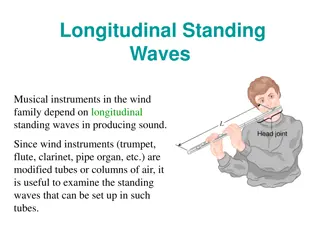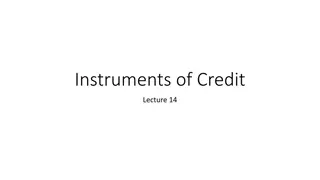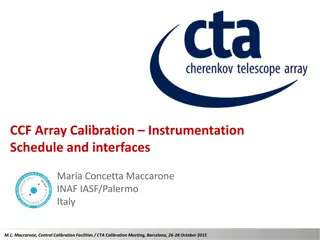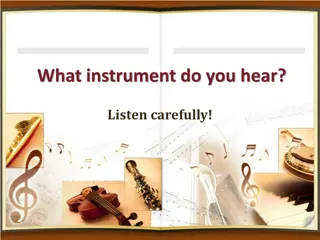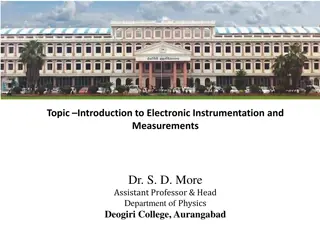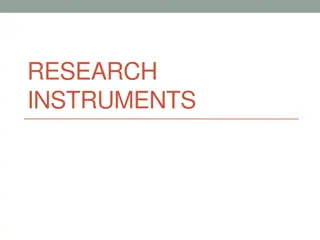Understanding Static and Dynamic Characteristics of Instruments in Measurements and Instrumentation
This educational material delves into the functional elements of an instrument, static and dynamic characteristics, and the importance of accuracy and sensitivity. It covers topics such as linearity, repeatability, speed of response, and more. The content provides valuable insights for students and professionals in the field of Electrical and Electronic Engineering.
Download Presentation

Please find below an Image/Link to download the presentation.
The content on the website is provided AS IS for your information and personal use only. It may not be sold, licensed, or shared on other websites without obtaining consent from the author. Download presentation by click this link. If you encounter any issues during the download, it is possible that the publisher has removed the file from their server.
E N D
Presentation Transcript
Measurements and Instrumentation A. Paramasivam Assistant Professor/EEE B. S. Abdur Rahman Crescent Institute of Science & Technology Department of EEE/BSA CRESCENT IS & T
FUNCTIONAL ELEMENTS OF AN INSTRUMENT Measured Medium Measured quantity Data storage/ playback element Primary sensing element Variable Conversion element Variable Manipulation element Data Data Transmission element presentation element Presented data Observer Department of EEE/BSA CRESCENT IS & T
STATIC AND DYNAMIC CHARACTERISTICS The performance characteristics of an instrument are mainly classified into two categories: Static Characteristics (do not vary with time) The set of criteria defined for the instruments, which do not vary with time. Dynamic Characteristics (vary with time) The set of criteria defined for the instruments, which varies with respect to time. Department of EEE/BSA CRESCENT IS & T
The various static characteristics are Accuracy Linearity Repeatability Threshold Tolerance, etc. The various dynamic characteristics are Speed of response Measuring lag Dynamic error - Sensitivity - Reproducibility - Resolution - Stability Department of EEE/BSA CRESCENT IS & T
Static Characteristics Accuracy: degree of closeness of a measured value to a standard or true value. Sensitivity: the smallest change in the measured value to which the instrument responds. In other words, it is the ratio of the changes in the output of an instrument to a change in the value of the quantity to be measured. Department of EEE/BSA CRESCENT IS & T
Static Characteristics Sensitivity can be expressed by: Sensitivity = qo/ qi Department of EEE/BSA CRESCENT IS & T
Static Characteristics Linearity: the ability to reproduce the input characteristics linearly. The curve shows the actual calibration curve & idealized straight line. Department of EEE/BSA CRESCENT IS & T
Static Characteristics Reproducibility: degree of closeness with which a given value may be repeatedly measured. It is specified in terms of scale readings over a given period of time. Repeatability: the variation of scale reading & random in nature. Resolution: If the input is slowly increased from some arbitrary input value, it will again be found that output does not change at all until a certain increment is exceeded. This increment is called resolution. Department of EEE/BSA CRESCENT IS & T
Static Characteristics Threshold: If the instrument input is increased very gradually from zero there will be some minimum value below which no output change can be detected. This minimum value defines the threshold of the instrument. Stability: the ability of an instrument to retain its performance throughout is specified operating life. Tolerance: The maximum allowable error in the measurement is specified in terms of some value which is called tolerance. Department of EEE/BSA CRESCENT IS & T
Dynamic Characteristics Speed of response The rapidity with which a measurement system responds to changes in the measured quantity. Measuring lag Delay in the response of a measurement system to changes in the measured quantity. Dynamic error Otherwise called as measurement error. Difference between the true value of the quantity changing with time and the value indicated by the measurement system (provided no static error is assumed) Fidelity: degree to which a measurement system indicates changes in the measurand quantity without dynamic error. Department of EEE/BSA CRESCENT IS & T
Measurement Error The measurement error is defined as the difference between the true value or actual value and the measured value. The true value is the average of the infinite number of measurements, and the measured value is the precise value. In general, the errors in measurement are classified into three types. They are Gross Error Systematic Error Random Error Department of EEE/BSA CRESCENT IS & T
Types of Errors in Measurement Department of EEE/BSA CRESCENT IS & T
Gross Errors occurs due to human mistakes. (For example: taking the wrong reading leads to incorrect data) It can only be avoided by taking the reading carefully. These errors are very common and the complete elimination is not possible. Some of the gross error easily detected by the experimenter but some of them are difficult to find. Two methods can remove the gross error. The reading should be taken very carefully. Two or more readings should be taken of the measurement quantity. The readings are taken by the different experimenter and at a different point for removing the error. Department of EEE/BSA CRESCENT IS & T
Systematic Errors The systematic errors are mainly classified into three categories. Instrumental Errors Environmental Errors Observational Errors Instrumental Errors These errors mainly arise due to the three main reasons. Inherent Shortcomings of Instruments Misuse of Instrument Loading Effect Department of EEE/BSA CRESCENT IS & T
Instrument Errors Inherent Shortcomings of Instruments Such types of errors are inbuilt in instruments because of their mechanical structure. They may be due to manufacturing, calibration or operation of the device. These errors may cause the error to read too low or too high. For example If the instrument uses the weak spring then it gives the high value of measuring quantity. The error occurs in the instrument because of the friction or hysteresis loss. Department of EEE/BSA CRESCENT IS & T
Instrument Errors Misuse of Instrument The error occurs in the instrument because of the fault of the operator. A good instrument used in an unintelligent way may give an enormous result. For example the misuse of the instrument may cause the failure to adjust the zero of instruments, poor initial adjustment, using lead to too high resistance. These improper practices may not cause permanent damage to the instrument, but all the same, they cause errors. Department of EEE/BSA CRESCENT IS & T
Instrument Errors Loading Effect It is the most common type of error which is caused by the instrument in measurement work. For example, when the voltmeter is connected to the high resistance circuit it gives a misleading reading, and when it is connected to the low resistance circuit, it gives the dependable reading. This means the voltmeter has a loading effect on the circuit. The error caused by the loading effect can be overcome by using the meters intelligently. Department of EEE/BSA CRESCENT IS & T
Environmental Errors These errors are due to the external condition of the measuring devices. Such types of errors mainly occur due to the effect of temperature, pressure, humidity, dust, vibration or because of the magnetic or electrostatic field. The following corrective measures shall be employed to eliminate these undesirable effects, The arrangement should be made to keep the conditions as constant as possible. Using the equipment which is free from these effects. By using the techniques which eliminate the effect of these disturbances. By applying the computed corrections. Department of EEE/BSA CRESCENT IS & T
Observational Errors Such types of errors are due to the wrong observation of the reading. There are many sources of observational error. For example, the pointer of a voltmeter resets slightly above the surface of the scale. To minimise the parallax error highly accurate meters are provided with mirrored scales. Random Errors The error which is caused by the sudden change in the atmospheric condition, such type of error is called random error. These types of error remain even after the removal of the systematic error. Hence such type of error is also called residual error. Department of EEE/BSA CRESCENT IS & T
STATISTICAL EVALUATION OF MEASUREMENT DATA Out of all the various possible errors, the random errors cannot be determined in the ordinary process of measurements. However, these errors can be treated mathematically. The mathematical analysis measurements is called statistical analysis of the data. of the various Department of EEE/BSA CRESCENT IS & T
STATISTICAL EVALUATION OF MEASUREMENT DATA For statistical analysis, the same reading is taken number of times, generally using different observers, different instruments & by different ways of measurement. The statistical analysis helps to determine analytically the uncertainty of the final test results. Arithmetic mean & median Average deviation Department of EEE/BSA CRESCENT IS & T
STATISTICAL EVALUATION OF MEASUREMENT DATA When the n umber of readings of the same measurement are taken, the most likely value from the set of measured value is the arithmetic mean of the number of readings taken. The arithmetic mean value can be mathematically obtained as, This mean is very close to true value, if number of readings is very large. Department of EEE/BSA CRESCENT IS & T
STATISTICAL EVALUATION OF MEASUREMENT DATA For a set of measurements X1, X2, X3 Xn written down in the ascending order of magnitudes, the median value is given by, The deviation tells us about the departure of a given reading from the arithmetic mean of the data set, Department of EEE/BSA CRESCENT IS & T
Calibration & Standards National Standard Organization (Primary reference standards) Standards Laboratory (Secondary reference standards) Company Instrument Laboratory (Working Standards) Process Instruments Department of EEE/BSA CRESCENT IS & T
Calibration & Standards When the working standard instrument has been calibrated by an authorized standards laboratory, a calibration certificate will be issued. This will contain at least the following information: the identification of the equipment calibrated the calibration results obtained the measurement uncertainty any use limitations on the equipment calibrated the date of calibration the authority under which the certificate is issued. Department of EEE/BSA CRESCENT IS & T
References Doebelin Application and Design", McGraw Hill Publishing Company, 1990. Murthy, D.V.S., "Transducer and Instrumentation", Prentice Hall of India Pvt. Ltd., 1995. Stout ,M.B., "Basic Electrical Measurement", Prentice Hall of India Morris, A.S ,"Principle of Measurement and Instrumentation", Prentice Hall of India, 1999. E.O., "Measurement Systems - Department of EEE/BSA CRESCENT IS & T
Thank You Department of EEE/BSA CRESCENT IS & T



